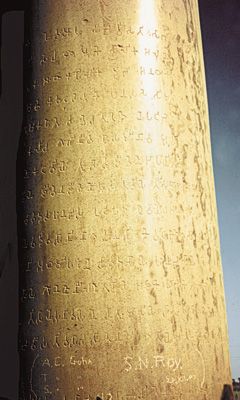Brahmi
Our editors will review what you’ve submitted and determine whether to revise the article.
Brahmi, writing system ancestral to all Indian scripts except Kharoshthi. Commonly believed by scholars to be of Aramaic derivation or inspiration, Brahmi first appears as a fully developed system in the 3rd century bce, and its most notable instance is on the rock edicts of Ashoka (reigned c. 265–238 bce). Brahmi is semialphabetic, each consonant having either an inherent a sound pronounced after it or a diacritic mark to show another vowel; initial vowels have separate characters. In most cases Brahmi and its derivatives are written from left to right, but an early coin discovered in the state of Madhya Pradesh is inscribed with Brahmi characters running from right to left, and there are instances of Brahmi written from right to left in Sri Lanka, although these are rare exceptions.
Among the many descendant scripts of Brahmi are those of the Indo-Gangetic Plain, such as Devanagari (used for Sanskrit, Hindi, and other regional languages) and the Bengali and Gujarati scripts; those of the Deccan region, including the scripts for Tamil, Telugu, Malayalam, and Kannada; the script for Sinhala in Sri Lanka; that of Tibetan in the Tibetan Highlands; and several alphabets in Southeast Asia, including those for Thai and Khmer.
After the positional decimal system was perfected by Indian mathematicians, forms of the Brahmi numerals for 1 through 9 diffused throughout the world, ultimately evolving into the numerals used in modern Devanagari in the Indian subcontinent, the Hindu-Arabic numerals used in Europe and the Americas, and the East Arabic numerals used in the Middle East.













